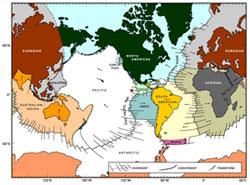Dehydration, the key to the deep earthquake

It seems that the continental plates are thicker than the oceanic ones, while the oceanic plates are more compact. In addition, at high pressures and temperatures at great depth, the continental plate is melted. Therefore, when colliding, the oceanic plate is introduced under the continental. As the plate sinks, there are continuous earthquakes at 600 km of depth. The problem is that the earthquakes are due to the break of the rocks, but below 50 km, due to the high temperature and pressure, the rocks have plastic characteristics that do not break. However, these earthquakes occur, but ask seismologists from the American coast of Oregon and Washington, or from the Chilean or Japanese coast. How?
To answer this question, the geophysics of the University of London and the University of Bayreuth in Germany have worked together. The serpentine rock is typical of the inner layer of the earth, the mantle, and the behavior of the serpentine has been analyzed at high temperatures and pressures. Thus, the chemical reactions that occur in this situation have found that the water containing the serpentine is removed. As reactions advance, water accumulates in the outer pores of the rock, and finally water breaks the rock. Therefore, the earthquake occurs when the rocks dehydrate and break.
According to the researchers, this experiment explains what happens in the subsoil. However, there are others who say that to fulfill it it is essential that there are many serpentines, and they believe that to see if this is so, more work will have to be done.
Buletina
Bidali zure helbide elektronikoa eta jaso asteroko buletina zure sarrera-ontzian











